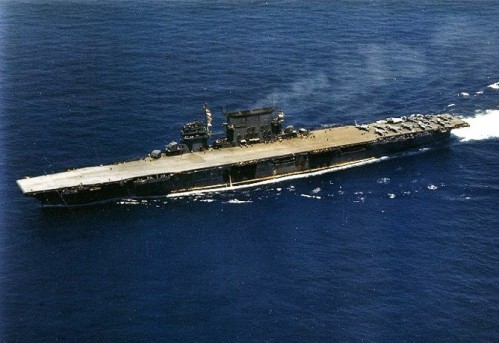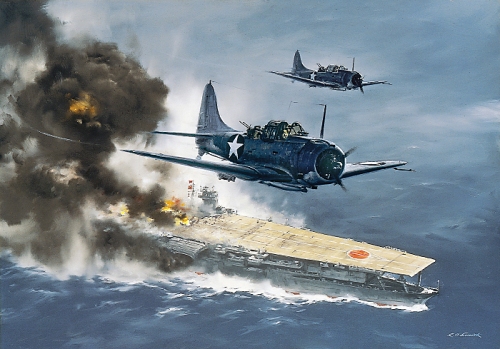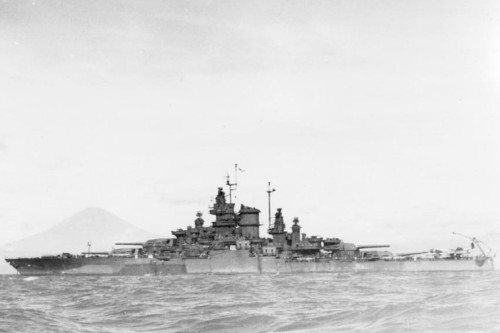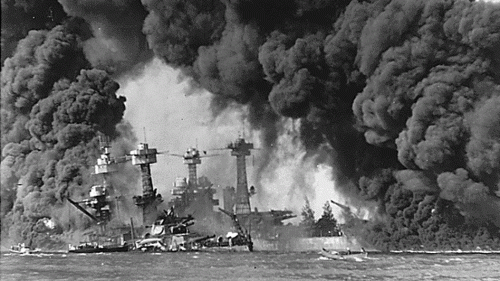Friends of Padre Steve’s World,
On the morning of December 7th 1941 8 of the 9 Battleships assigned to the US Pacific Fleet were in Pearl Harbor. Seven, the USS California, USS Maryland, USS Oklahoma, USS Tennessee, USS West Virginia, USS Arizona and USS Nevada were moored on Battleship Row. The USS Pennsylvania was in the massive dry dock which she shared with the destroyers USS Cassin and USS Downes. The USS Colorado, a sister ship of Maryland and West Virginia was at the Puget Sound Naval Yard being overhauled.
USS West Virginia sinking at left and USS Tennessee burning at Pearl Harbor
At the time both the United States Navy and the Japanese Imperial Navy still viewed the Battleships as the heart of the fleet and the essence of naval power. Aircraft Carriers were still viewed as an adjunct and support to the traditional battle line.
 Japanese Aircraft preparing to launch at Pearl Harbor
Japanese Aircraft preparing to launch at Pearl Harbor
Thus as the Japanese Carrier Strike Group, the Kido Butai under the command of Vice Admiral Chūichi Nagumo approached Pearl Harbor and intelligence reports came in indicating that the carriers were not present the Japanese were not overly concerned. The lack of concern was in a sense ironic because the force they assigned to destroy the Battleships of the Pacific Fleet was the carrier strike group, not their battle line. The Kido Butai was the largest carrier strike group assembled until late 1943 when the U.S. Pacific Fleet fielded a larger carrier strike group, something no other country has done since.
The Kido Butai enroute to Pearl Harbor
Comprised of six carriers, the Akagi, Kaga, Hiryu, Soryu, Shokaku and Zuikaku the force embarked over 300 first line aircraft. The aviators of the air groups aboard the carriers had been training for months to attack Pearl Harbor. Their aircraft had been specially outfitted with Type 91 Model 2 aerial torpedoes designed to run in the shallow waters of Pearl Harbor and Type 99 Model 5 armor piecing bombs modified from battleship shells. These weapons would be employed with a devastating effect on the morning of December 7th 1941.
The three carriers assigned to the Pacific Fleet, the USS Saratoga, USS Lexington and USS Enterprise had been dispatched on missions that took them away from Pearl Harbor that fateful Sunday.
USS Lexington
The Lexington and Task Force 12 had departed Pearl Harbor on December 5th to ferry 18 SB2U Vindicator Dive Bombers of VSMB-231 to Midway Island. These aircraft would ultimately take part in the Battle of Midway and the sinking of the Japanese Cruiser Mikuma. Saratoga was entering San Diego to embark her air group, and Enterprise which had left Pearl Harbor on November 28th to deliver VMF-211 to Wake Island was due to return to Pearl Harbor on the 7th of December. As such none of these ships were in Pearl Harbor at the time of the attack. Their absence helped save the United States and Allied cause in the Pacific.
USS Saratoga
The United States had other carriers but all were assigned to the Atlantic Fleet due to the belief that Nazi Germany was a greater threat than Japan. The USS Yorktown was at Norfolk in between deployments in support of the Neutrality Patrol. USS Ranger was returning to Norfolk from a Neutrality patrol, USS Wasp was at Grassy Bay Bermuda and the newly commissioned USS Hornet was training out of Norfolk. The USS Long Island, the first Escort carrier was undergoing operational tests and training out of Norfolk.
Had any of the three carriers assigned to the Pacific Fleet been in Pearl Harbor on the morning of the Japanese attack the results would have been even more disastrous for the United States. Instead these carriers began operations against the Japanese almost immediately. Carriers based on the East Coast including Hornet, Yorktown and Wasp were transferred to the Pacific. In the perilous months following the Pearl Harbor attack the US carriers took the fight to the Japanese conducting raids against Japanese held islands. In April 1942 the Enterprise and Hornet, the latter with 16 B-25 Mitchell bombers under the command of Colonel Jimmy Doolittle struck Tokyo.
USS Hornet launching the Doolittle Raiders
The result of that attack resulted in a severe embarrassment and loss of face to the Imperial Navy. the strategic and psychological implications were such that Admiral Isoruku Yamamoto decided to attack Midway Island to force the US fleet and its carriers into a decisive battle. Although the Japanese had lost a good number of aircrew from Shokaku and Zuikaku at the Battle of Coral Sea, while sinking Lexington Yamamoto remained committed to the decisive battle.
That battle was decisive, but not in the way Yamamoto had planned. Akagi, Kaga, Hiryu and Soryu were sunk by aircraft operating from Enterprise, Yorktown and Hornet. Yorktown was lost in the battle bat it was a decisive defeat for the Japanese. From that point, though they still were superior to the U.S. Navy in numbers of Carriers and surface warships, and still maintained a massive number of islands which they had fortified and built airbases on in defiance of treaties they agreed to at the end of the First World War,
Sinking the Akagi at Midway
In the succeeding months in the vicious battles around the Solomon Islands the remaining US carriers proved decisive. Although Wasp and Hornet were sunk in those battles and both Saratoga and Enterprise were often heavily damaged, they held the line. The carriers that the Japanese missed proved decisive in turning the tide and winning the war.
Raised from the mud of Pearl Harbor the USS West Virginia in Tokyo Bay
Though Yamamoto did not realize it, the attack on Pearl Harbor signaled the end of the supremacy of the Battleship and the ascendency of the Aircraft Carrier. By 1943 Battleships were regulated to escorting the fast carrier task forces or conducting shore bombardments. The ultimate irony was that the last battleship engagement in history was won by the survivors of the attack on Pearl Harbor. Raised from the mud the West Virginia, Tennessee, California, Maryland and Pennsylvania joined by the USS Mississippi rained destruction on two Japanese task forces attempting to penetrate Leyte Gulf and destroy the US invasion force transports at the Battle of Surigao Strait.
It was a fascinating turn of events. The Japanese dispatched the cream of their carrier air forces to destroy the U.S. Pacific Fleet at Pearl. Harbor, and though they crippled the battleships they failed to destroy the American aircraft carriers, at Pearl Harbor, Coral Sea, Midway, or the Guadalcanal campaign. In the following years the Enterprise and Saratoga, bolstered by the carriers of the Essex Class, and the Light Fleet Carriers of the Independence Class, and helped by the addition of dozens of Escort Carriers, which relieved them of the mundane tasks of convoy escort and amphibious landing support, wreaked havoc on the Imperial Japanese Navy from late 1943 on. The Battles of the Philippine Sea, Leyte Gulf, the raid on Formosa, and the strikes on the Japanese homeland proved the superiority of the carrier force the Japanese missed at Pearl Harbor and failed to destroy in subsequent engagements.
Today, nearly eight decades later there is a question of the relevance of aircraft carriers, even though the United States, Great Britain, China, Russia, India, and other nations continue their development. I have to admit, that with the development of other weapons platforms and technologies, that I do not know the ultimate fate of the aircraft carrier. However, like the Ships of the Line that dominated late 17th, 18th, and early 19th centuries., the Ironclads that dominated the late 19th Century, and the Dreadnaughts that dominated until Pearl Harbor.
Pearl Harbor was 78 years ago. Since then carrier and submarine eclipsed the power of the the battleship. We cannot assume that the era of the aircraft carrier will continue without end. The Japanese discounted the power of the aircraft carrier and submarine, assuming that battleships supported by carriers and submarines would maintain control of the Oceans. They were wrong. Regardless of what weapons system we presume will dominate the future, we also must admit the very real possibility that we could be wrong. Technologies that we have not ever began to imagine, except possibly in the realm of science fiction may change everything we believed possible.
i am neither the prophet nor the son of the prophet, thus my opinion is only that: I believe that the carrier will remain the centerpiece of Naval power and strategy for the next decade, and possibly another, but as a military and Naval historian I cannot predict that they remain so longer than that. Thus the United States Navy, and for that matter all navies begin looking toward and planning for technologies that are either in their infancy or not yet imagined. To ignore that fact would be to ignore history. We do that to our detriment.
Until tomorrow,
Peace,
Padre Steve+











